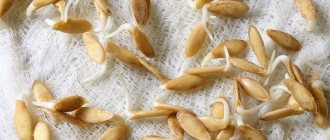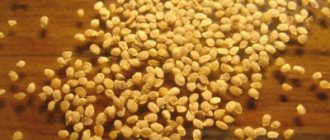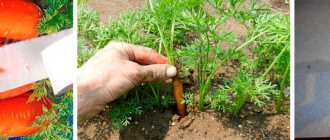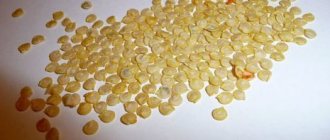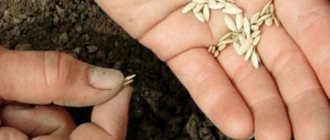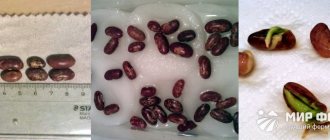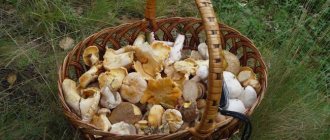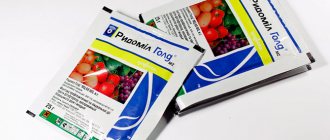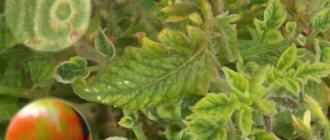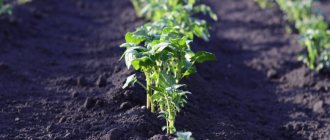Many summer residents, sowing seeds of various vegetables and flowers, discovered that their germination rate was very low, despite the good appearance of the seed and compliance with planting rules. Therefore, it is so important to be able to determine germination, which will not only reduce unproductive labor costs, but also get a wonderful harvest and beautiful flower beds. The germination of flower seeds (asters, for example) and vegetables (e.g. eggplant) depends on various factors: storage time and temperature, time of harvesting the seed, germination time.
How quickly do seedlings appear?
Different crops may have different germination times. For most of them (cucumbers, tomatoes, peppers, asters, etc.) the average period is 7-10 days. Favorable conditions for rapid germination are
- constant moderate humidity,
- room temperature within 20-25º,
- sufficient ventilation, lack of air access will lead to spoilage of seeds,
- For the germination of some varieties of flowers and greenery, lighting is required, you can read about this on the packaging.
Testing seeds for germination: timing of germination
To check seeds for germination, it is important to know the timing when they should germinate. As a rule, seeds require different times. It ranges from 7 to 14 days. We invite you to familiarize yourself with the germination times of the most popular crops:
Germination time
This table will help you navigate and understand when certain crops should sprout.
How long do seeds remain viable?
The shelf life of the seeds is of no small importance. When buying ready-made seeds in stores, always check the expiration date. Usually it does not exceed 2-3 years. But some seeds remain viable even after the designated period, especially since they need to be checked.
Cucumber seeds remain viable when stored even after 7-9 years; buying them expired is not so scary. But lettuce or parsnips are unlikely to sprout. A completely different situation is when packages with asters indicate an expiration date of 2-3 years, but in fact their germination rate drops to 20% the very next year.
What is seed germination
If expressed in the language of agronomists, this is the percentage ratio of sprouted seeds to the number of sown ones. That is, how much seed material will sprouts produce under conditions acceptable to them.
How healthy and strong the seed is and how quickly it will germinate in natural conditions, without using additional growth stimulants.
Not all seeds germinate at the same time. Some of them will begin to hatch within a couple of days. Others will take much longer. But, on average, the largest number of them will begin to germinate in one or two weeks.
The older the seed, the longer it will take to germinate. If they do not show signs of life for a long time, or even more so become moldy, such a seed should definitely be thrown away.
Each type of garden crop begins to grow at a different time, and the timing of their germination is also different.
The most common crops:
- Legumes (peas and beans) germinate within one week. Their seeds are suitable for planting for no more than 6 years;
- Tomatoes, peppers and eggplants sprout within two weeks. Their lifespan is 5 years;
- Carrot seeds will sprout in 10 days. They can be stored for 2-3 years;
- Cucumbers, watermelons and melons, zucchini and pumpkins begin to hatch already on the 3rd day. They can be planted for 6-8 years;
- Cabbage sprouts within 10 days. Seeds can be stored for 5 years, no more;
- Radishes and radishes hatch on the 7th day. They are suitable for planting for 4-5 years;
- Corn will sprout on the 5th day. The shelf life of its seed is not long, and is 2-3 years.
READ ALSO: Is it necessary to treat a greenhouse against late blight in the fall
? The temperature at which seeds should germinate is not lower than +20 °C and not higher than +30 °. Dill seeds can germinate at lower temperatures from 8 to 12 degrees Celsius.
Basically, all seed packages indicate the percentage of germination. And it's big enough. And when sowing them at home, it happens that very few will sprout, but the rest will die.
Does this mean that the manufacturer is deceiving us? Not at all, because it indicates the germination of seeds in the most optimal conditions for them (laboratory). What can be achieved at home with great difficulty.
What affects seed germination
Over time, sprout germination may decline. So, if in the first year the indicator is 90-95%, this is the norm. Next year it can be 80%, after 2 years - 50%, and after 3-4 years - 30-40%. Moreover, germination is affected by:
- expired;
- improper storage - lack or excess of moisture;
- low or high room temperature;
- lack of air access;
- conditions for their germination have not been created, for example, petunia seeds will not sprout if they are sprinkled with earth or covered with thick fabric;
- the quality of the seeds themselves is unripe, overdried, damaged by pests or diseases.
How to increase
Energen
Heteroauxin
Copper sulfate
Boric acid
Potassium permangantsovka
Pre-treatment can give an impetus to the germination of even low-quality seeds:
- Soaking in a solution of stimulants (preparations Energen, Heteroauxin) or microelements (copper sulfate, boric acid, potassium permanganate - 2 g per 1 liter of water). The seeds are poured with a prepared solution at a temperature of 20 degrees for 3 to 4 hours.
- Hardening . The seeds are soaked for 15 - 18 hours in water + 20 degrees. Then placed in the refrigerator for 14 days.
- Warming up in hot water . The seeds are placed in water heated to +50 degrees for 20 minutes. Then rinse with cold water.
The method of heating in hot water is not recommended for tomatoes. In this crop, the procedure slows down the germination process.
How to test seed germination at home
There are several ways to check seed germination.
Fast way
In salted water, the germination of cucumbers, tomatoes, zucchini, squash, feathers, radishes, spinach, lettuce, corn, flowers, etc. is checked. To do this, add 1 teaspoon of salt to a glass of water and stir until the salt dissolves. Then 10 seeds are poured into the solution. Stir them in water, wait 5-7 minutes and see what happens and determine the percentage of germination.
Dry empty seeds remain on the surface of the water and are thrown away without regret. Good, viable ones remain at the bottom. They can be dried and stored until planting.
In a solution of potassium permanganate . The method is similar to the previous one. To check, the seeds are immersed in a saturated solution of potassium permanganate. They look at which seeds float on the surface and which ones sink to the bottom. This method is good because the seeds are disinfected simultaneously with the test. This check can be carried out the day before sowing seeds for seedlings.
Germination
Sowing in the ground. Seeds are sown in a container with prepared soil, then covered with a layer of soil. The soil is moistened, and the container is placed in a plastic bag or covered with cling film on top. Don’t forget to sign what you planted, the number of seeds, and the planting date. The number of seeds must be known to determine the percentage of germination. If you planted 10 seeds, 9 of them sprouted, then the germination percentage is 90%. Or out of 10 6 seedlings sprouted, then this is 60%.
Germination on fabric. Take a thick cloth, a cotton pad, a paper towel, moisten them with water at room temperature, and place 10 seeds on top. Check every day, do not allow the cloth with seeds to dry out, moisten it.
To speed up germination, use
- plant growth stimulants (Heteroauxin, Kornevin, Etamon, Zircon, etc.),
- heating the seeds in warm water (50ºС) for 6 hours, then washing them in cold water (tomato feed),
- hardening, when the seeds are dipped in warm water (50ºC) and then in cold water. This is done 3 times a day for two days;
- Borbotation.
Bubbling is the treatment of seeds with oxygen or air in water. Bubbling removes the effect of inhibitors in the seed that delay germination, ensures uniform pipping and germination of seeds, increases field germination, enhances the initial growth of seedlings and accelerates the ripening of the crop by several days.
How to test seeds of peppers, cucumbers, tomatoes, soybeans for germination: methods
Some novice gardeners believe that checking seeds for germination is an unnecessary procedure, since everything is indicated on the package. However, in the end the result is disappointing. This is due to the fact that laboratory germination is written on the packaging, which is determined when the seeds are in almost ideal conditions. Therefore, the indicators are almost one hundred percent. In real conditions, such a result is almost impossible to achieve. This germination is called field germination. It is determined by the number of healthy shoots obtained after planting.
Seed check
There are several ways to test seeds for germination. Let's look at them.
Method 1. Germination in damp cloth
This method allows you to understand how high the germination energy is. For an accurate result, it is necessary to take a large amount of seed material. Therefore, the method is more relevant for checking personally collected materials.
The check is carried out like this:
- First, fold gauze or thin cotton cloth into three layers
- Lightly moisten the seeds and place them on the prepared surface. Quantity may vary. In this case, the smaller the seeds, the more they will be needed.
- It is recommended to place the gauze on a small saucer
- Cover it with another similar piece of gauze on top.
- Moisten the seeds with water and cover with an inverted plate
Place the finished “structure” in a warm place where the air temperature does not drop below 18 degrees. If the culture is cold-resistant, then the temperature can reach +25 degrees. For heat-loving people, it is allowed from +25 to +30. While your seeds are germinating, inspect them regularly and keep the cheesecloth moist. Never let it dry out. In addition, plastic containers with a lid, such as those used for salads or baked goods, are suitable for germination testing.
It is important to remove already sprouted seeds during the procedure. In each batch, count the quantity and record the result. Counting is carried out throughout the entire period. Upon completion, determine how many seeds did not sprout. For example, if 50 out of 100 seeds sprouted, then the germination percentage will be 50.
Method 2: Paper napkin
Seeds
There is also a less expensive testing method in terms of seeds. However, it allows you to get only an approximate result. Many people use it when there is no large supply of seed.
- Place a paper napkin or towel on a saucer and moisten it with water
- Place about a dozen seeds on it and place cling film on top
- Place the saucer in a warm place where the temperature does not exceed +20 - +22 degrees
- Inspect daily and, if necessary, moisten the cloth. It shouldn't dry out
Upon completion of the germination period allotted for the crop, calculate the percentage of germination.
Checking the germination of carrots
Carrot seeds usually germinate in 30-40 days due to the prolonged dissolution of the tannin shell. They protect the seeds from frost, delaying the emergence of seedlings. If you only need to soak the seeds of other plants in water to determine their germination, then with carrots you will have to work a little. But this must be done. Due to the long period of seedling germination and lost time, poor-quality planting material can leave you without this useful vegetable.
- Take a piece of thick fabric, sprinkle dry seeds on it, then tie the ends of the fabric with an elastic band to make a fabric bag;
- Pour water into a bowl (50ºС) and lower the bag into the water for a few minutes, then immediately immerse it in another container with cold water, also for a few minutes. This is done three times a day. After 2 days, all tannins from the surface of the seeds will be washed off. Remove the seeds from the bag and dry them on a plate or paper towel;
- Pour a 2-3 cm layer of soil into a shallow container (box), scatter the seeds, and then add a thin layer of soil on top. Moisten the soil. The first shoots should appear in 10-15 days. You can check germination by spreading the seeds between layers of damp cloth.
Dear readers, if you are not sure about the quality of the seeds, be sure to check them for germination without waiting for the start of the gardening season.
Have a good harvest!
Determination methods
There are several ways to check germination energy at home. Each of them has certain characteristics.
In saline solution
This method is a cross between calibration and germination control. The seeds are dipped in small portions into a solution of table salt (30–50 g per 1 liter of water) or potassium permanganate (1 g per 1 liter). After 20 - 30 minutes, large, full-bodied specimens will sink to the bottom of the container, while empty ones will remain on the surface. They are merged with part of the solution. High-quality seeds are washed and dried.
Expert opinion
Chernyaeva Tatyana Dmitrievna
Absolutely loves gardening and grows only organic vegetables
Ask a Question
If the test is carried out immediately before sowing, you can use hot (60 degrees) water. The seeds are poured in, covered with a lid and left until the water cools completely. The specimens that have settled to the bottom are sown in seedling boxes or soil.
In cloth or napkins
For the process, use thick cloth, napkins or toilet paper:
- The material is placed on the bottom of a plate or other container and moistened with warm water from a spray bottle.
- Place the counted number of seeds at a short distance from each other.
- Cover with a second layer of material and moisten it.
- Place the container in a warm place (26 - 27 degrees), with dim lighting.
It is better not to use gauze or other porous material for germination. The sprouts that appear penetrate into its structure, and it is impossible to separate them without damage.
Do you determine the similarity of seeds before planting?
I always want to try
In sawdust or sand
The method is recommended for use for crops with large seeds - corn, beets, melons, beans, beans, peas, pumpkins, zucchini. For the procedure, take washed coarse river sand or sawdust steamed in a water bath for 30 minutes. The substrate is poured into shallow containers and moistened.
Then, in rows, at a distance of 1.5 - 2 cm, the seeds are distributed on the surface. Sprinkle them with a layer of sand or sawdust 0.5 cm high. The optimal temperature for seed germination is +23 – 27 degrees.
In the package
The seeds are laid out on one side of a plastic bag and lightly moistened with a spray bottle. Cover with the other side and tie. Several holes are pierced on the surface for air access. In the heat, the full-fledged seeds inside the bag quickly swell and sprout.
Germination is an important quality of seeds
When planning to purchase seeds, especially in large quantities for planting in a field or a collective garden or just at the dacha, you need to make sure of their high quality, otherwise you may not get a harvest and suffer losses.
Currently, the seed material of all agricultural crops is expensive, so if you are offered cheap seeds, this is a reason to think about their quality.
Let's consider what characteristics distinguish high-quality seeds from low-quality ones, why and how to determine their germination independently without a laboratory.
Storage rules
To ensure that the seed does not lose its viability during storage, it is important to create certain conditions for it. The main enemies of seeds are high temperature and humidity. After collection, they should be placed in thick paper bags and kept in a dry room at a temperature of + 15 to 25 degrees.
Breeder, candidate of agricultural sciences Galina Kuzmitskaya advises storing seeds in glass jars or bottles. The containers should be sealed with plastic lids or stoppers and placed in the refrigerator in the vegetable compartment. Under such conditions, maximum germination is maintained.
Once you are convinced of the quality of the seed material, you can safely begin growing seedlings. The check must be carried out in advance, before the sowing time arrives.
Which seeds to check and which not
Germination testing may be necessary in the following cases:
- if you are not sure that high-quality seeds are being purchased;
- seeds from your own harvest;
- the seeds were stored for more than 5 years.
In specialized stores, as a rule, there are certificates indicating the year the seeds were received, the period of their sale and laboratory germination. Under natural conditions, the laboratory germination rate will be slightly lower.
Important!
Please note that germination is not tested for encrusted and chemically treated seeds as this is done during the production of such seeds prior to chemical treatment.
What to do with the test results?
Knowing the germination rate of seeds, you can correctly calculate the sowing rate and find a replacement for absolutely non-germinating seeds in time. Seeds are considered qualified (suitable for sowing) if the number of germinated seeds is 90% or more. Such seeds do not require the use of methods to increase germination. Although modern means for pre-sowing seed treatment also have a preventive effect - they increase the resistance of seeds to diseases and different growing conditions.
If the germination level is within 50%, then experts recommend increasing the seeding rate by 2 times.
If the indicator is below 30%, it is not advisable to sow seeds. Of course, if we are not talking about valuable or rare plants that must be preserved.
